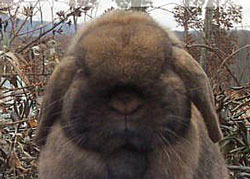Advantages and Disadvantages to Different Breeding Strategies
In addition to selecting pairs to mate based on complementary faults and strengths, try to select rabbits with common ancestors. Here’s why. Holland lops are a relatively new breed, having been around for only decades compared to centuries for some breeds. There are several breeds of rabbit that were used in creating the Holland Lop. Hollands, therefore, produce much more variability than more established breeds. You are hoping, therefore, to “line up” some of the good genes in your bunnies so that you can produce more predictable results.
Until you can produce predictable results, there will always be a very large “chance” component to any breeding you do. You want to narrow the range of genes, sort out the poor results, collect up the good results and continue on in your breeding program until you are producing more predictable (and better) results. Once you have a line established, you can evaluate the faults that you produce on a fairly regular basis. Then you want to start or bring in another line that has a strength in that area. After a minimum of two generations, and perhaps more, you are ready to improve your two lines by outcrossing. Outcrossing is the breeding of two rabbits from unrelated lines.
 Inbreeding is breeding brother to sister. Inbreeding is a great way to “set” the characteristics of the sire and dam. When you inbreed, you have a greater chance of genes “lining up,” both good and bad. When you inbreed, cull heavily, only keeping what you are really pleased with. Because the poor characteristics are just as “set” as the good ones.
Inbreeding is breeding brother to sister. Inbreeding is a great way to “set” the characteristics of the sire and dam. When you inbreed, you have a greater chance of genes “lining up,” both good and bad. When you inbreed, cull heavily, only keeping what you are really pleased with. Because the poor characteristics are just as “set” as the good ones.
The rabbit in the top picture has a poor shape to the head. You should breed it to a rabbit with a good shape to the head, like the rabbit below.
Next Article: Calculating Which Day Your Rabbit Mommy will give Birth.


